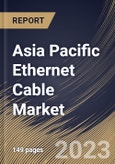Ethernet cables have long been the backbone of network connectivity, facilitating the seamless exchange of information and enabling the digital age to flourish. These cables are the unsung connectivity heroes used in diverse settings, from home networks and small businesses to large data centers and industrial applications. This vital network infrastructure component is responsible for transmitting data at high speeds and maintaining the reliability and security of the digital interactions.
As data demands increase, the industry gradually shifts towards fibre optic ethernet cables. Fiber optic cables offer significantly higher bandwidth and faster data transfer rates than traditional copper cables. They are becoming increasingly prevalent in data centers and high-speed networks as they are better equipped to handle the burgeoning data traffic. The integration of power over ethernet (PoE) technology is a noteworthy trend in the market. PoE allows data and power to be transmitted over a single ethernet cable, simplifying the deployment of devices like IP cameras, access points, and IoT sensors. This trend has acquired traction due to its cost-effective and efficient approach.
According to International Trade Administration, Japanese manufacturing companies are estimated to have spent $890 million on digital infrastructure. This figure is estimated to grow to $4.1 billion by 2030. For the past decade, value-added manufacturing in Japan has accounted for more than 20 percent of Japan’s GDP. Manufacturing companies often have multiple production sites. It connect these sites to centralized systems, facilitating centralized management and remote access. The factors mentioned above will propel the market growth in this region.
The China market dominated the Asia Pacific Ethernet Cable Market by Country in 2022, and would continue to be a dominant market till 2030; thereby, achieving a market value of $2,433.9 Million by 2030. The Japan market is exhibiting s a CAGR of 11.2% during (2023 - 2030). Additionally, The India market would experience a CAGR of 12.7% during (2023 - 2030).
Based on Type, the market is segmented into Copper, and Fiber-Optic. Based on Application, the market is segmented into Commercial, Industrial, and Residential. Based on Cable Type, the market is segmented into Unshielded Twisted Pair, and Shielded Twisted Pair. Based on countries, the market is segmented into China, Japan, India, South Korea, Singapore, Malaysia, and Rest of Asia Pacific.
The market research report covers the analysis of key stake holders of the market. Key companies profiled in the report include Hitachi, Ltd., Rockwell Automation, Inc., Schneider Electric SE, Belden, Inc., Prysmian Group, Nexans S.A., Anixter International Inc., Siemens AG, The Siemon Company, Leviton Manufacturing Co., Inc.
Scope of the Study
Market Segments Covered in the Report:
By Type (Volume, Million Meter, USD Billion, 2019 to 2030)- Copper
- Fiber-Optic
- Commercial
- Industrial
- Residential
- Unshielded Twisted Pair
- Shielded Twisted Pair
- China
- Japan
- India
- South Korea
- Singapore
- Malaysia
- Rest of Asia Pacific
Key Market Players
List of Companies Profiled in the Report:
- Hitachi, Ltd.
- Rockwell Automation, Inc.
- Schneider Electric SE
- Belden, Inc.
- Prysmian Group
- Nexans S.A.
- Anixter International Inc.
- Siemens AG
- The Siemon Company
- Leviton Manufacturing Co., Inc.
Unique Offerings
- Exhaustive coverage
- The highest number of Market tables and figures
- Subscription-based model available
- Guaranteed best price
- Assured post sales research support with 10% customization free
Table of Contents
Companies Mentioned
- Hitachi, Ltd.
- Rockwell Automation, Inc.
- Schneider Electric SE
- Belden, Inc.
- Prysmian Group
- Nexans S.A.
- Anixter International Inc.
- Siemens AG
- The Siemon Company
- Leviton Manufacturing Co., Inc.
Methodology

LOADING...








